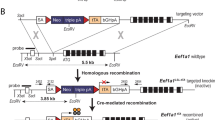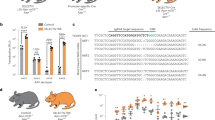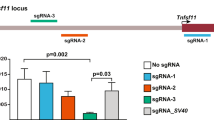Abstract
Transgenic mice have been used as models for tissue-specific gene regulation and to examine the molecular and cellular effects of altered expression of specific genes in disease processes such as tumorigenesis. Because of the deleterious effects of constitutive expression of transgenes, which frequently result in prenatal or postnatal death, only a limited number of disease models have been established in transgenic mice. We report an inducible binary transactivation system that permits the control of transgene expression in a tissue-specific and inducible fashion in mice. In this system, transcription of the target transgene is kept silent until turned on by the administration of an exogenous compound. We also demonstrate that expression level of the target gene can be induced three to four orders of magnitude and can be controlled by the administrated compound in a dose-dependent manner.
This is a preview of subscription content, access via your institution
Access options
Subscribe to this journal
Receive 12 print issues and online access
$209.00 per year
only $17.42 per issue
Buy this article
- Purchase on Springer Link
- Instant access to full article PDF
Prices may be subject to local taxes which are calculated during checkout
Similar content being viewed by others
References
Bienz, M. and Pelham, H.R. 1986. Heat shock regulatory elements function as an inducible enhancer in the Xenopushsp70 gene and when linked to a heterolo-gous promoter. Cell 45: 753–760.
Bairn, S.B., Labow, M.A., Levine, A.J. and Shenk, T. 1991. A chimeric mammalian transactivator based on the lac represser that is regulated by temperature and isopropyl β-D-thiogalactoside. Proc. Natl. Acad. Sci. USA 88: 5072–5076.
Mayo, K.E., Warren, R. and Palmiter, R.D. 1982. The mouse metallothionein-l gene is transcriptionally regulated by cadmium following transfection into human or mouse cells. Cell 29: 99–108.
Wang, Y., O'Malley, B.W., Jr Tsai, S.Y. and O'Malley, B.W. 1994. A regulatory system for use in gene transfer. Proc. Natl. Acad. Sci. USA 91: 8180–8184.
Gossen, M., Freundlied, S., Bender, G., Muller, G., Hillen, W. and Bujard, H. 1995. Transcriptional activation by tetracyclines in mammalian cells. Science 268: 1766–1769.
No, D., Yao, T.-R. and Evans, R.M. 1996. Ecdysone-inducible gene expression in mammalian cells and transgenic mice. Proc. Natl. Acad. Sci. USA 93: 3346–3351.
Spencer, D.M., Wandless, T.J., Schreiber, S.L. and Crabtree, G.R. 1993. Controlling signal transduction with synthetic ligands. Science 262: 1019–1024.
Yan, C., Costa, R.H., Darnell, J.E., Jr Chen, J. and Van Dyke, T.A. 1990. Distinct positive and negative elements control the limited hepatocyte and choroid plexus expression of transthyretin in transgenic mice. EMBO J. 9: 869–878.
Wu, H., Wade, M., Krall, L., Grisham, J., Xiong, Y. and Van Dyke, T.A. 1996. Targeted in vivo expression of the cyclin-dependent kinase inhibitor p21 halts hepatocyte cell-cycle progression, postnatal liver development and regeneration. Genes & Development 10: 245–260.
Chung, J.H., Whiteley, M. and Felsenfeld, G. 1993. A 5′ element of the chicken β-globin domain serves as an insulator in human erythroid cells and protects against position effect in Drosophila. Cell 74: 505–514.
Cai, H. and Levine, M. 1995. Modulation of enhancer-promoter interactions by insulators in the Drosophilaembryo. Nature 376: 533–536.
Brand, A.H. and Perrimon, N. 1993. Targeted gene expression as a means of altering cell fates and generating dominant phenotypes. Development 118: 401–415.
Ornitz, D.M., Moreadith, R.W. and Leder, R. 1991. Binary system for regulating transgene expression in mice: Targeting int-2 gene expression with yeast GAL4/UAS control elements. Proc. Natl. Acad. Sci. USA 88: 698–702.
Murad, F. and Haynes, R., 1985. pp. 1366–1371, in Goodman and Oilman's The Pharmacological Basis of Therapeutics, ed 7. MacMillan, New York.
Heikinheimo, O. and Kekkonen, R. 1993. Dose-response relationships of RU 486. Ann. Med. 25: 71–76.
Shi, Y.E., Ye, Z.H., He, C.H., Zhang, G.Q., Xu, J.Q., Van Look, P.F. et al. 1993. Pharmacokinetic study of RU 486 and its metabolites after oral administration of single doses to pregnant and non-pregnant women. Contraception 48: 133–149.
Kawai, S., Nieman, L.K., Brandon, D.D., Udelsman, R., Loriaus, D.L. and Ghrousos, G.R. 1987. Pharmacokinetic properties of the antiglucocorticoid and antiprogesterone steroid RU 486 in man. J. Pharmacol. Exp. Therapeutics 241: 401–406.
Palmiter, P.D., Norstedt, G., Gelinas, R.E., Hammer, R.E. and Brinster, R.L. 1983. Metallothionein-human GH fusion genes stimulated growth of mice. Science 222: 809–814.
Spitz, I.M. and Bardin, C.W. 1993. Mifepristone (RU 486)—a modulator of prog-estin and glucocorticoid action. N. Engl. J. Med. 329: 404–412.
Grunberg, S.M., Weiss, M.H., Spitz, I.M., Ahmadi, J., Sadum, A., Russell, C.A. et al. 1991. Treatment of unresectable meningiomas with the antiprogesterone agent mifepristone. J. Neursurg. 74: 861–866.
Borgden, R.N., Goa, K.L. and Faulds, D., 1993. ne, a review of its phar-macodynamic and pharmacokinetic properties, and therapeutic potential. Drugs B>45:384–409.
Felsenfeld, G., Boyes, J., Chung, J., Clark, D. and Studitsky, V. 1996. Chromatin structure and gene expression. Proc. Natl. Acad. Sci. USA 93: 9384–9388.
Zhao Keji Hart, C.M. and Laemmli, U.K. 1995. Visualization of chromosomal domains with boundary element-associated factor BEAF-32. Cell 81: 879–889.
Reneker, L.W., Silversides, D.W., Patel, K. and Overbeek, P.A. 1995. TGFα can act as a chemoattractant to perioptic mesenchymal cells in developing mouse eyes. Development 121: 1669–1680.
Author information
Authors and Affiliations
Rights and permissions
About this article
Cite this article
Wang, Y., DeMayo, F., Tsai, S. et al. Ligand-inducible and liver-specific target gene expression in transgenic mice. Nat Biotechnol 15, 239–243 (1997). https://doi.org/10.1038/nbt0397-239
Received:
Accepted:
Issue Date:
DOI: https://doi.org/10.1038/nbt0397-239
This article is cited by
-
The chicken hypersensitive site-4 insulator cannot fully shield the murine phosphoglycerate kinase-1 promoter from integration site effects in transgenic mice
3 Biotech (2019)
-
Efficient ROSA26-Based Conditional and/or Inducible Transgenesis Using RMCE-Compatible F1 Hybrid Mouse Embryonic Stem Cells
Stem Cell Reviews and Reports (2013)
-
The cHS4 chromatin insulator reduces gammaretroviral vector silencing by epigenetic modifications of integrated provirus
Gene Therapy (2008)
-
Regulation of endogenous gene expression using small molecule-controlled engineered zinc-finger protein transcription factors
Gene Therapy (2007)
-
Reporter mice and drug discovery and development
Nature Reviews Drug Discovery (2005)



